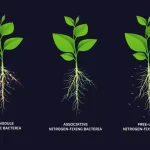Are your crops not thriving as they should? If you’ve noticed stunted growth, yellowing leaves, or poor yield, your plants might be crying out for help.
Understanding nutrient deficiency in crops is crucial for any farmer or gardener looking to ensure a bountiful harvest. Imagine being able to decode your plants’ silent signals and transforming them into lush, productive fields. This knowledge not only saves you time and money but also boosts your confidence as a grower.
Dive into the secrets of spotting nutrient deficiencies, and unlock the potential of your crops like never before. Your plants are counting on you!

Common Signs Of Nutrient Deficiency
Understanding nutrient deficiency in crops is crucial for healthy growth. Nutrient deficiencies can severely affect yield and quality. Identifying these signs early helps in taking corrective measures. Here are common signs that indicate nutrient deficiency in crops.
Yellowing Leaves
Yellowing leaves often signal a lack of essential nutrients. Nitrogen deficiency is a typical cause. Without nitrogen, plants struggle to produce chlorophyll. Chlorophyll is vital for photosynthesis. Inspect leaves regularly for color changes.
Stunted Growth
Stunted growth is another sign of nutrient deficiency. Phosphorus deficiency frequently causes slow growth. Phosphorus is critical for energy transfer in plants. Lack of phosphorus leads to weak, small plants. Observe crop growth patterns for abnormalities.
Poor Root Development
Weak roots indicate nutrient shortages. Potassium deficiency affects root health. Potassium strengthens root systems and water uptake. Without enough potassium, roots become fragile. Examine roots for strength and size.
Leaf Curling
Leaf curling often points to calcium deficiency. Calcium is essential for cell structure and growth. Lack of calcium leads to distorted leaves. Check leaf shapes for unusual curling or twisting.
Necrotic Spots
Necrotic spots are dead areas on leaves. Magnesium deficiency usually causes these spots. Magnesium is necessary for chlorophyll production. Without it, leaves develop brown or black patches. Inspect leaves for necrotic spots regularly.
Poor Fruit Development
Poor fruit development signals nutrient issues. Boron deficiency affects fruit growth. Boron is crucial for cell wall formation. Lack of boron leads to underdeveloped fruits. Monitor fruit size and quality closely.

Diagnostic Tools And Techniques
Detecting nutrient deficiency in crops involves observing leaf discoloration, stunted growth, and abnormal patterns. Soil testing and plant tissue analysis provide precise insights into missing nutrients. Timely identification ensures healthier crops and maximizes yield potential.
Identifying nutrient deficiency in crops is crucial for maintaining healthy and productive fields. Diagnostic tools and techniques can help you pinpoint the specific nutrients your crops are lacking. By understanding these methods, you can take timely corrective actions to ensure your plants thrive. Understanding the tools at your disposal can make a significant difference in your crop’s health. ###Soil Testing Kits
Soil testing kits are a farmer’s best friend. They provide insights into the nutrient levels of your soil. With them, you can easily determine which nutrients are lacking and need to be added. Imagine checking your garden’s soil and finding out it needs more nitrogen. You’d know exactly what to do next. ###Visual Inspection
Visual inspection is one of the oldest techniques. It involves observing your crops for signs of deficiency. Yellowing leaves or stunted growth can indicate specific nutrient issues. However, visual symptoms can sometimes be misleading. It’s always a good idea to confirm your observations with other methods. ###Plant Tissue Analysis
Plant tissue analysis takes the guesswork out of diagnosing deficiencies. By examining the plant’s tissue, you can get a clear picture of its nutrient content. This method often requires sending samples to a lab. But the detailed results are worth the wait. ###Mobile Apps
Modern technology has brought diagnostic tools to your fingertips. Several mobile apps can help identify nutrient deficiencies based on photos of your crops. These apps use machine learning and databases to suggest possible deficiencies. While not always 100% accurate, they offer a good starting point. ###Electronic Sensors
Electronic sensors are becoming more popular in precision agriculture. They provide real-time data on soil conditions and plant health. Using sensors, you can monitor changes in nutrient levels and respond quickly. This proactive approach can save crops from significant damage. ###Consulting Experts
Sometimes, seeking the guidance of an expert can be invaluable. Agronomists and extension officers have the experience and knowledge to diagnose problems accurately. Their insights can be especially useful if you’re dealing with multiple issues. Don’t hesitate to reach out if you’re unsure about your findings. Have you ever thought about the impact of timely nutrient correction on your crop yield? The right diagnosis can be the difference between a successful harvest and a disappointing one. By using these tools and techniques, you can ensure your crops get the nutrients they need. Equip yourself with knowledge, and watch your fields flourish.Impact On Crop Yield And Quality
Nutrient deficiency in crops can significantly decrease yield and quality. Signs like yellow leaves or stunted growth help identify problems early. Addressing these deficiencies ensures healthier plants and better harvests.
Identifying nutrient deficiencies in crops is crucial because it directly affects yield and quality. When plants lack essential nutrients, they can’t grow properly, leading to reduced harvests and lower quality produce. Recognizing these issues early can save you time and resources while ensuring your crops reach their full potential.Impact On Crop Yield
Nutrient deficiencies can drastically reduce crop yield. Imagine spending months tending to your fields, only to find that your harvest is half of what you expected. This can happen if plants don’t receive enough nutrients like nitrogen, phosphorus, or potassium. These elements are vital for plant growth and development. A lack of them results in stunted growth and fewer crops. Keep an eye out for signs like yellowing leaves or poor fruit development. Addressing these issues promptly can help maintain your expected yield.Influence On Crop Quality
The quality of your crops is just as important as the quantity. Nutrient deficiencies can lead to poor texture, color, and taste. Have you ever bitten into a fruit that looked ripe but tasted bland? This can be a result of nutrient deficiency. For instance, a lack of calcium can cause fruits to develop bitter pits, making them unsellable. Ensuring your plants receive the right nutrients not only improves their appearance but also enhances their flavor and nutritional value.Recognizing Subtle Signs
Sometimes, nutrient deficiencies aren’t obvious. They might not show dramatic symptoms but can still affect your crops. Subtle signs, like slightly curled leaves or uneven growth, can indicate a problem. Take a moment to regularly inspect your plants for these minor changes. Early detection allows for quick intervention, saving your crops from long-term damage.Practical Tips For Prevention
Preventing nutrient deficiencies starts with soil testing. Knowing the nutrient content of your soil helps you make informed decisions about fertilization. Use balanced fertilizers to ensure plants get a mix of necessary nutrients. Rotate crops to avoid depleting the soil of specific nutrients over time. What steps are you taking to prevent nutrient deficiencies in your crops? Regular monitoring and proactive measures can make all the difference in your harvest. By understanding how nutrient deficiencies impact crop yield and quality, you can take steps to improve your farming practices. Regular observation and proactive management ensure your crops grow strong and healthy. Are you ready to boost your harvest and enhance the quality of your produce? Implement these strategies and see the difference in your fields.
Effective Remediation Strategies
Spotting nutrient deficiency in crops involves observing yellowing leaves, stunted growth, and poor fruit quality. Soil testing helps identify missing nutrients like nitrogen, phosphorus, or potassium. Address deficiencies through targeted fertilization and improved soil management.
Identifying nutrient deficiencies in crops is only the first step. The real challenge lies in addressing these deficiencies effectively. Implementing the right remediation strategies can significantly improve the health and yield of your crops. Let’s dive into practical solutions that can guide you through this crucial phase.Soil Testing And Amendment
Begin by testing your soil. A simple soil test can reveal what nutrients are lacking. With this information, you can add the appropriate fertilizers or organic matter to balance the nutrient profile. Consider your own garden. Have you ever noticed a plant that just doesn’t thrive? Sometimes, adding compost can make all the difference. Try integrating organic matter into your soil to enrich its nutrient content.Foliar Feeding
Foliar feeding is a quick way to supply nutrients directly to the plant leaves. This method is especially effective for micronutrient deficiencies. Imagine walking through your field and noticing yellowing leaves. A foliar spray can address this issue faster than soil amendments alone. It’s a practical solution when time is of the essence.Crop Rotation
Rotate crops to manage soil fertility. Different plants have unique nutrient needs and rotating them can prevent depletion of specific nutrients. Think of crop rotation as nature’s way of balancing the soil. If you’ve grown tomatoes in one spot this year, try planting beans next time. This simple switch can naturally restore nutrients without added chemicals.Companion Planting
Use companion planting to optimize nutrient availability. Some plants can enhance the growth of others by naturally enriching the soil. Have you ever planted basil near tomatoes? Basil can deter pests while enhancing the flavor of your tomatoes. Such combinations can also improve soil health, making them a win-win strategy.Regular Monitoring
Regularly monitor your crops for signs of nutrient deficiency. Early detection can save you time and resources. Picture yourself as a detective in your own garden. Observing changes in leaf color or plant growth can provide clues about nutrient issues. This proactive approach keeps your crops thriving. What strategies have worked for you in the past? Feel free to share your experiences and tips in the comments below. Your insights could be the key to helping others overcome their crop challenges.Conclusion
Spotting nutrient deficiencies in crops is crucial for healthy growth. Regularly check leaves and stems for color changes. Monitor plant size and leaf shape too. These signs often indicate nutrient issues. Quick action helps restore balance. Use fertilizers based on specific needs.
Consult agricultural experts if unsure. Early detection saves time and resources. Healthy crops lead to better yields. Paying attention ensures strong, productive plants. Stay observant and proactive. Your crops depend on it. Keep learning and adapting. Successful farming requires ongoing attention and care.
Your dedication pays off with thriving plants. Happy farming!

